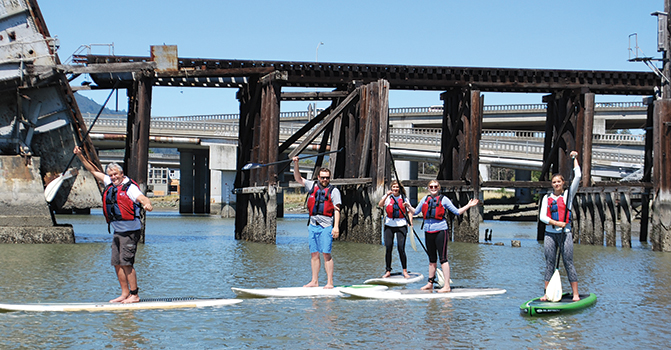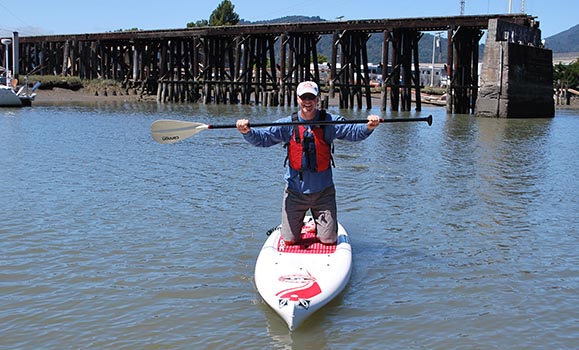Last summer, I took Bay Crossings readers on a kayaking trip to Tomales Bay.

Outback Adventures’ “intro to SUP” class took place on the protected waters of Corte Madera Creek, right next to the Larkspur Ferry Terminal. It was a great family activity, especially since it was Father’s Day. Photo by Joel Williams
By Joel Williams
Published: July, 2015
Last summer, I took Bay Crossings readers on a kayaking trip to Tomales Bay. This year, I decided to stay closer to home and try something that has intrigued me for some time now. I travelled to Larkspur to learn stand-up paddleboarding (SUP).
The concept of standing up while paddling watercraft is far from new. African and South American tribes with river and coastal cultures have paddled while standing up in canoes and rafts for thousands of years. However, the SUP sport that we see today really began taking off in the United States around 2005. The first production paddleboards were brought to market in 2006 and the sport is still evolving. Today, you can see people SUPing with their dogs or even taking a paddleboard yoga class.
Because I had absolutely no experience, I signed up for Outback Adventures’ “intro to SUP” class. The 2.5-hour class took place at 9 a.m. on the protected waters of Corte Madera Creek, right next to the Larkspur Ferry Terminal. It was Father’s Day, which also happened to be the first day of summer, and although most of the Bay Area was still blanketed in fog, I was amazed to see the sun shining when I arrived, eliminating the need for wetsuits.
The class began with a quick overview of the sport and equipment involved. After practicing a couple of stroke techniques on the shore, we were out on the water. We started out kneeling on the boards while paddling and were told to stand up once we were moving. This was surprisingly easy and most everyone was up and paddling away within a few minutes. It turns out that the board is more stable when in motion, so standing still is actually harder than moving forward.
Soon everyone was up and scooting along the water in varying stages of comfort when the first splash happened. Close to the shore, someone had slipped off her board while trying to maneuver back to the open water. The instructor had her back up and paddling in no time and thanks to the sunny day, the drenched girl said the water wasn’t too cold. I was just happy it wasn’t me.
After gaining much confidence regarding my SUP skills, I began practicing a maneuver making a 360-degree turn while remaining in one place. After successfully completing this once, I immediately attempted the same thing in the other direction. And that’s when it happened…
Remember I told you that a paddleboard is the least stable while standing still? Well, I was leaning forward with my paddle and lost my balance. I overcorrected myself and took a step backwards and just kept going. What ensued next can best be described as a reenactment of the Nestea plunge commercials from the 1980s; as I fell backwards, both my arms began windmilling before I landed in the water with a spectacular spread-eagle backflop. If you are too young to remember the Nestea plunge, look it up on YouTube.
Only two of the seven participants in the group ended up in the water, so it wasn’t the norm. Everyone was able to grasp the techniques taught to us and the instructor was very helpful, especially getting me back up on the board, which was easier than I imagined.
The last 30 minutes of the class were spent allowing everyone to demo various types and sizes of boards and paddles available to see which were the most comfortable to use. Some are built for speed but are less stable, while other more stable boards would be better for the yoga class or taking Fido for a ride than for racing with your friends.
The class was very enjoyable and I now have the skills needed to rent a paddleboard in the future without hesitation if the opportunity arises while on vacation. The class will also give you the necessary information to help make an informed decision when purchasing new equipment. The cost for a decent new paddleboard starts at around $750 and can exceed $1,500 for some top-of-the-line models (with paddles ranging from $50 to $150) so it’s a good idea to take a class first to make sure this is the sport for you before making that investment.
If you are interested in pursuing the SUP experience for yourself, check out the monthly Waterfront Activities section of each issue of Bay Crossings for information on future SUP classes and trips available in the Bay Area.

To get started stand-up paddleboarding, you begin by paddling on your knees (a). Once you are moving, you brace yourself with the paddle in front of you and slowly stand up (b). Once you are underway (c), the board is more stable when you are moving than standing still. Photos by Joel Williams

If you are interested in pursuing stand-up paddleboarding, check out the monthly Waterfront Activities section of Bay Crossings on pages 22-23 for information on future classes and trips. Photo by Joel Williams

